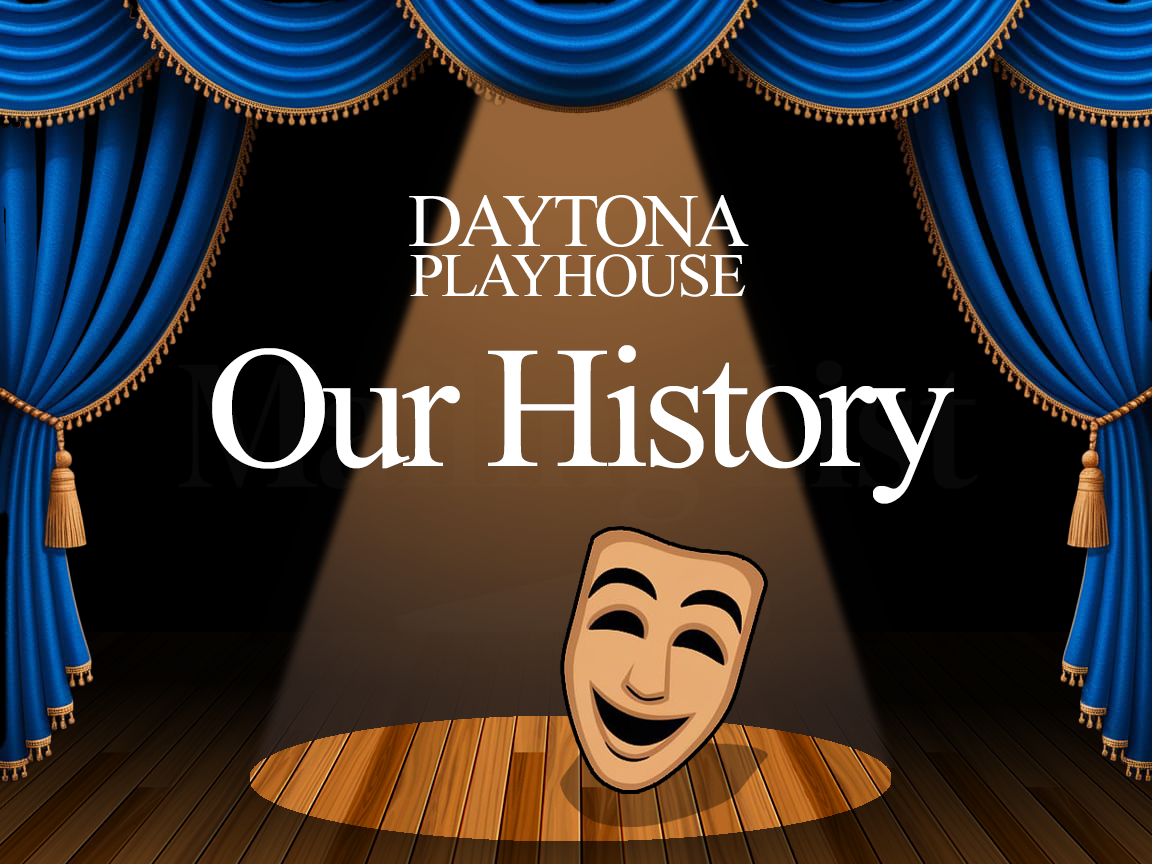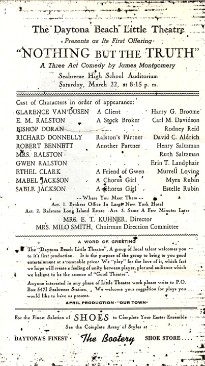

Our first program from Nothing But the Truth in March of 1947.

Only known photo from Welch Auditorium.
Taken during the run of The Man From Cairo in January of 1948.

Backstage at the Princess Theatre in the early 1950s. Martha Hixson, prompter, with Paul Edson, crew.

The cast of Sabrina Fair, the first play staged in our current building in 1956.
Long before there was a stage to call home, there was a dream.
The spark that would become the Daytona Playhouse was ignited in January 1947, when a small group of visionaries gathered to discuss forming a community theatre. From that meeting, the Daytona Beach Little Theatre was born — officially organized that month and chartered the following year. These early dreamers, fueled by a love of theatre and the belief that the arts belonged to everyone, laid the foundation for what would become a cultural cornerstone in Volusia County.
Daytona Beach has a rich dramatic past dating back to the 1880s, with various theatrical groups staging performances in the area. Yet none had staying power until the Little Theatre took root. In its early days, the company performed wherever space was available — Seabreeze High School, the Recreation Hall on City Island, and a chapel repurposed as a theater in the Welch Area on the current grounds of Daytona State College. The passion of the volunteers was unwavering, even when faced with loss. On the evening of Wednesday, March 14, 1951, a fire destroyed our first real home, wiping out four years' worth of sets, costumes, and scripts. With only $1,000 in insurance, we started again — this time using the theater located inside the historic Princess Issena Hotel on Seabreeze Boulevard.
It was there that Huron “Pop” Blyden became a guiding force. First as a volunteer and later as director, Pop’s leadership and vision helped us stabilize and grow. His contribution to the early days of the Little Theatre cannot be overstated.
In 1954, the dream of a permanent home became a reality. We purchased a lot on the Halifax River and launched an ambitious fundraising campaign. Thanks to stock sales and community donations, construction began in 1955. On March 25, 1956, the new building was dedicated before 400 guests. The building was modern for its time, with a 299-seat auditorium, a fly loft, orchestra pit, and fully-equipped stage — a testament to the influence and guidance of Pop Blyden, who supervised construction every step of the way.
On April 1, 1956, the new theatre opened with Sabrina Fair, directed by Pop himself. A new chapter had begun.
Throughout the late 1950s and 1960s, the theatre thrived. Under resident director Bryant Simms (1959–1967), musicals were added to the lineup, establishing a tradition that continues to this day. These crowd-pleasers broadened the our appeal and helped draw ever-larger audiences.
By 1968, the organization's impact had grown so significantly that we officially changed our name to Daytona Playhouse, reflecting our broadening artistic scope and deeper roots in the community.
The Playhouse has never been just about productions. Over the years, it has served as a cultural hub, welcoming guests from across Florida and beyond. We have offered summer theatre for youth, opened our doors to local organizations, and hosted statewide festivals. From the Florida Theatre Conference to special performances for visually-impaired patrons, the Playhouse has remained committed to outreach and accessibility.
In 1972, on the occasion of our Silver Anniversary, the Playhouse proudly celebrated 25 years of community-driven theatre. By then, the season included seven or more performances per show and a growing membership, some of whom had supported the theatre from its earliest days.
The Daytona Playhouse has now staged thousands of performances across more than seven decades, with an ever-evolving mix of classics, comedies, thrillers, dramas, and contemporary musicals. From Our Town and Life With Father to Spamalot, Something Rotten!, and Vanya and Sonia and Masha and Spike, we have welcomed generations of actors, directors, and audiences into the fold.
Even as the world changed, the Playhouse adapted while staying true to our roots. In both the 2015-2016 and 2023-2024 seasons, the building underwent significant renovations to enhance the experience for both patrons and performers — including a new box office, expanded restrooms, ADA access to the stage, an enlarged workshop, and a wheelchair lift.
What began as a hopeful conversation over tea has become a living tradition. Families — sometimes three generations deep — now tread the boards, volunteer both front-of-house and backstage, and fill the seats. The Playhouse remains a place where community and creativity come together.
What’s next for Daytona Playhouse? That answer lies in every new script, every audition, and every laugh or tear shared in the darkened house. The curtain continues to rise — not just on plays, but on possibility.
As we look to the future, we honor the dreamers and doers who brought us here, and we welcome the next generation of artists and audiences with open arms.